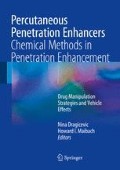Abstract
Liquid crystals are intermediate states of matter or mesophases, a halfway between an isotropic liquid and a solid crystal. The penetration-enhancing ability of liquid crystals (LC) in topical formulations applied to the skin was evaluated by measuring in vitro, through excised hairless rat, the permeation profile of a model compound, calcein, entrapped in the LC formulation. Two physically stable formulations with LCs were prepared from a mixture of mono-, di-, and triesters (1) and monoesters (2) composed of erythritol and phytanylacetic acid. Cryo-transmission electron microscopy (cryo-TEM) and electron diffraction pattern observations of the LC nanodispersions showed that the structure of the LCs was reverse hexagonal (LC-A) and cubic (LC-B). The skin permeation of calcein was enhanced by its entrapping in LCs due to the increase in calcein partition from the LC dispersion into the skin, which was analyzed by the skin permeation-time profile. This chapter shows that LC dispersions can be used as topical carrier systems in drug formulations as well as in cosmetic formulations.
Access this chapter
Tax calculation will be finalised at checkout
Purchases are for personal use only
References
Abraham W, Downing DT (1989) Preparation of model membranes for skin permeability studies using stratum corneum lipids. J Invest Dermatol 93:809–813
Barauskas J, Landh T (2003) Phase behavior of phytantriol/water system. Langmuir 19:9562–9565
Brinon L, Geiger S, Alard V, Doucet J, Tranchant JF, Couarraze G (1999) Percutaneous absorption of sunscreens from liquid crystalline phases. J Control Release 60:67–76
Conn CE, Drummond CJ (2013) Nanostructured bicontinuous cubic lipid self-assembly materials as matrices for protein encapsulation. Soft Matter. doi:10.1039/C3SM27743G
Dingler A, Gohla S (2002) Production of solid lipid nanoparticles (SLN): scaling up feasibilities. J Microencapsul 19:11–18
Esposito E, Cortesi R, Drechsler M, Paccamiccio L, Mariani P, Contado C, Stellin E, Menegatti E, Bonina F, Puglia C (2005) Cubosome dispersions as delivery systems for percutaneous administration of indomethacin. Pharm Res 22:2163–2173
Esposito E, Drechsler M, Mariani P, Sivieri E, Bozzini R, Montesi L, Menegatti E, Cortesi R (2007) Nanosystem for skin hydration: a comparative study. Int J Cosmet Sci 29:39–47
Fang J, Hong C, Chiu W, Wang Y (2001) Effect of liposomes and niosomes on skin permeation of enoxacin. Int J Pharm 219:61–72
Geraghty PB, Attwood D, Collett JH, Sharma H, Dandiker Y (1997) An investigation of the parameters influencing the bioadhesive properties of Myverol 18–99/water gels. Biomaterials 18:63–67
Gin DL, Pecinovsky CS, Bara JE, Kerr RL (2008a) Functional lyotropic liquid crystal materials. Liquid crystalline functional assemblies and their supramolecular structures and bonding. 128:181–222
Gin DL, Pecinovsky CS, Bara JE, Kerr L (2008b) Functional lyotropic liquid crystal materials. Struct Bond 128:181
Garg G, Saraf S, Saraf S (2007) Cubosomes, an overview. Biol Pharm Bull 30:350–353
Gustafsson J, Ljusberg-Wahren H, Almgren M, Larsson K (1996) Cubic lipid-water phase dispersed into submicron particles. Langumuir 12:4611–4613
Hyde ST (1990) Curvature and the global structure of interfaces in surfactant-water systems. J Phys Colloq 51(C7):209–228
Israelachvili JN, Mitchel DJ, Ninham BW (1976) Theory of self-assembly of hydrocarbons amphiphiles into micelles and bilayers. J Chem Soc Faraday Trans 2(72):1525–1568
Kasha PC, Banga AK (2008) A review of patent literature for iontophoretic delivery and devices. Recent Pat Drug Deliv Formul 2:41–50
Kirjavainen M, Urtti A, Valjakka-Koskelab R, Kiesvaara J, Mönkkönena J (1999) Liposome–skin interactions and their effects on the skin permeation of drugs. Eur J Pharm Sci 7:279–286
Larsson K (1989) Cubic lipid-water phases: structure and biomembrane aspects. J Phys Chem 93:7304–7314
Lopes LB, Ferreira DA, de Paula D, Garcia MTJ, Thomazini JA, Fantini MCA, Bentley MVLB (2006a) Reverse hexagonal phase nanodispersion of monoolein and oleic acid for topical delivery of peptides: in vitro and in vivo skin penetration of cyclosporin A. Pharm Res 23:1332–1342
Lopes LB, Lopes JLC, Oliveira DCR, Thomazini JA, Garcia MTJ, Fantini MCA, Collett JH, Bentley MVLB (2006b) Liquid crystalline phases of monoolein and water for topical delivery of cyclosporin A, characterization and study of in vitro and in vivo delivery. Eur J Pharm Biopharm 63:146–155
Lopes LB, Speretta FFF, Bentley MVLB (2007) Enhancement of skin penetration of vitamin K using monoolein-based liquid crystalline systems. Eur J Pharm Sci 32:209–215
Müller RH, Mäder K, Gohla S (2000) Solid lipid nanoparticles (SLN) for controlled delivery – a review of the state of the art. Eur J Pharm Biopharm 50:161–177
Namdeo A, Jain NK (2002) Liquid crystalline pharmacogel based enhanced transdermal delivery of propranolol hydrochloride. J Control Release 82:223–236
Norlén L (2001) Skin barrier formation, the membrane folding model. J Invest Dermatol 117:823–829
Ogura M, Paliwal S, Mitragotri S (2008) Low-frequency sonophoresis: current status and future prospects. Adv Drug Deliv Rev 60:1218–1223
Phan S, Fong WK, Kirby N, Hanley T, Boyd BJ (2011) Evaluating the link between self-assembled mesophase structure and drug release. Int J Pharm 421:176–182
Purdon CH, Azzi CG, Zhang J, Smith EW, Maibach HI (2004) Penetration enhancement of transdermal delivery–current permutations and limitations. Crit Rev Ther Drug Carrier Syst 21:97–132
Silver B (1985) The physical chemistry of membranes. Solomon Press, Winchester
Tokudome Y, Sugibayashi K (2004) Mechanism of the synergic effects of calcium chloride and electroporation on the in vitro enhanced skin permeation of drugs. J Control Release 95:267–274
Tokumoto S, Mori K, Higo N, Sugibayashi K (2005) Effect of electroporation on the electroosmosis across hairless mouse skin in vitro. J Control Release 105:296–304
Yamaguchi Y, Nakamura N, Nagasawa T, Kitagawa A, Matsumoto K, Soma Y, Matsuda T, Mizoguchi M, Igarashi R (2006) Enhanced skin regeneration by nanoegg formulation of all-trans retinoic acid. Pharmazie 61:117–121
Yuli-Amar I (2008) Ph.D. Dissertation, The Hebrew University of Jerusalem
Author information
Authors and Affiliations
Corresponding author
Editor information
Editors and Affiliations
Rights and permissions
Copyright information
© 2015 Springer-Verlag Berlin Heidelberg
About this chapter
Cite this chapter
Kadhum, W.R., Todo, H., Sugibayashi, K. (2015). Skin Permeation: Enhancing Ability of Liquid Crystal Formulations. In: Dragicevic, N., Maibach, H. (eds) Percutaneous Penetration Enhancers Chemical Methods in Penetration Enhancement. Springer, Berlin, Heidelberg. https://doi.org/10.1007/978-3-662-45013-0_17
Download citation
DOI: https://doi.org/10.1007/978-3-662-45013-0_17
Publisher Name: Springer, Berlin, Heidelberg
Print ISBN: 978-3-662-45012-3
Online ISBN: 978-3-662-45013-0
eBook Packages: MedicineMedicine (R0)

